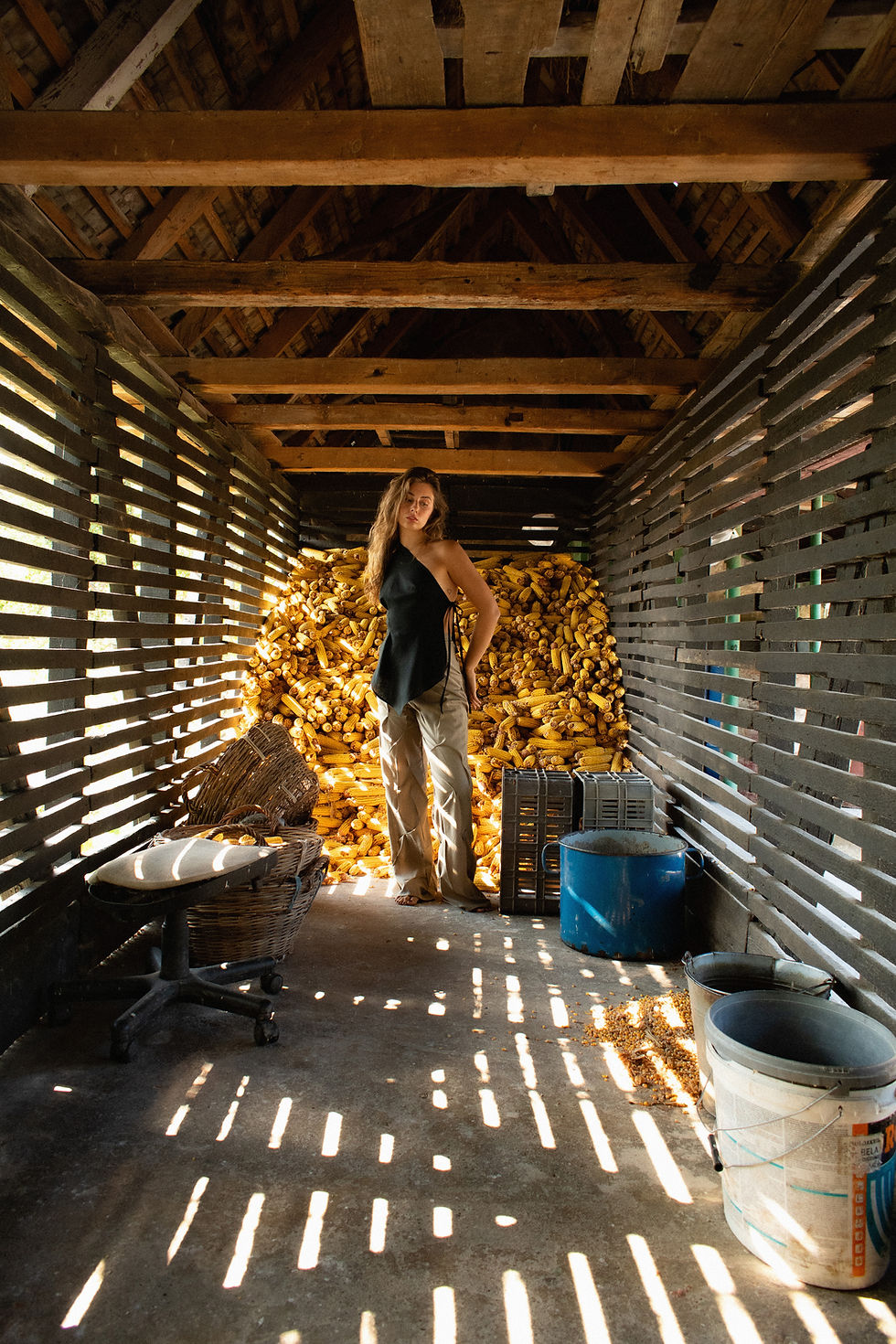Sara Savić’s Clothing Through Touch and Memory
- Savina Ražnatović
- Jun 8
- 4 min read
Updated: Jun 9
A rough piece of textile. A bar in a quiet village. A touch-triggered memory. This is where the creative process starts, not with a concept or a sketch but with something felt. What follows isn’t mapped out in advance; the garment takes shape gradually, guided by instinct and emotion. There is no formal boundary between making and research, between material and memory—everything unfolds together in a rhythm that is slow, tactile, and responsive. Based in Serbia, Savić doesn’t treat clothing as a product or trend but as a way of working through sensation. Her collections often begin with a small, specific detail: the texture of coarse fabric at a flea market, the shape of a passing figure, the faded atmosphere of a half-empty tavern. From there, the form reveals itself through movement, layering, and intuition rather than design formula.
What makes her approach so singular is the way she continuously gives up control. There is no fixed outcome, no sketch guiding the direction. Instead, she enters the work through contact and observation, allowing the material to set the pace. “There’s always that moment, when I touch a fabric and it pulls me into a memory or a feeling. That connection has to happen first. If the energy isn’t right, I can’t move forward.” Fabric, for her, is not something to dominate, but something to respond to. She lets the garment emerge through physical dialogue with texture and tension, shaping it as the process unfolds. In this space, design becomes something instinctive, relational, and emotionally tuned rather than predetermined. Color in her work is not used to attract attention but to deepen the atmosphere. She gravitates toward muted, earthy tones that reflect the qualities of the materials themselves, such as unbleached cotton, raw wool, or washed-out linen. These choices allow the surface to remain visible and honest. Rather than using color for contrast or visual effect, she uses it to hold the piece within a specific emotional tone—something quiet, weathered, and close to the body.
What sets Savić’s work apart is not only her process, but her refusal to turn references into aesthetic gestures. While many contemporary designers borrow from rural life as a visual motif, she builds directly from lived environments and emotional memory. These influences are not abstracted or styled for effect; they are carried forward with their texture, discomfort, and weight intact. This way of working does not seek approval or alignment. It exists on its own terms, shaped by touch, memory, and time, rather than by the rhythms of fashion systems or conceptual frameworks.
The same approach defines Uporište (Stronghold), a recent collection shaped by visual memories of women who spent their lives working in the fields of rural Serbia, tending land and enduring seasonal labor across generations.Drawing from old photographs and family stories, she began shaping a body of work that steers clear of nostalgia but stays rooted in memory.The silhouettes, long skirts, aprons, and headscarves, are not costume, but structural forms that verge on the symbolic.“Those pieces weren’t just clothes,” she says. “They were about survival. About holding something together through use, repetition, and necessity.”
By stripping away embellishment, she brought forward other forms of complexity. She placed coarse canvas next to light cotton, raw wool beside polished silk.The result is a minimalism that doesn’t feel empty but dense with contrast. Each piece reflects the physical demands of rural labor, such as bending, lifting, layering, and enduring. It also carries traces of the women who performed this work daily, not as a symbol, but as a shape of necessity.



During the development of Uporište (Stronghold), she found herself overthinking the work, trying to force it into a fixed shape. Eventually, she let go, and the process began to unfold more intuitively. That moment of release now shapes how she approaches her practice overall. She doesn't plan ahead or follow the momentum of the industry. Instead, her direction comes from the material, the emotion, or whatever surfaces in the moment. “As long as I still have imagination, I’ll keep making,” she says. This way of working also shapes how she relates to the wearer. She doesn’t design for a specific audience or market. “I just make the piece, and somehow, the person who needs it finds it. It’s like the piece already knows where it belongs.”
Because of the clarity with which she works, each piece develops its own rhythm that is influenced by context, emotion, and the physical surroundings. Whether it's a room, a scene, or a peaceful nook, the environment around a garment adds something necessary. A piece's energy and presence are often derived from the tension created by the contrast between it and its surroundings. Her work is driven by memory, emotional structure, and the notion that clothing is something lived in relation to time, light, and soil rather than the logic of fashion as a system. She frequently revisits the idea of going back to the roots, not to preserve them as fixed symbols but to remain connected to what still moves and breathes beneath the surface. It is there, in that base, that she locates something essential, a place where we are most ourselves.
Sara Savić (b. 1997, Belgrade, Serbia) is an emerging fashion designer whose practice re-imagines the attire of Balkan working women through modular silhouettes, material hybridity and zero-waste pattern-cutting. After completing the High School of Textiles in Belgrade, she earned a BA in Fashion Design at the Belgrade Polytechnic Academy in 2021. Savić has presented three independent collections—Intertwining (2021), Uporište / Stronghold (2023) and a forthcoming mini collection of four pieces for 2025—each distinguished by layered constructions, transformable garments and experimental draping that combine viscose, silk, linen and reclaimed workwear fabrics. She lives and works in Belgrade, where she is developing her eponymous label and advocating for small-batch, craft-oriented production.






Comments